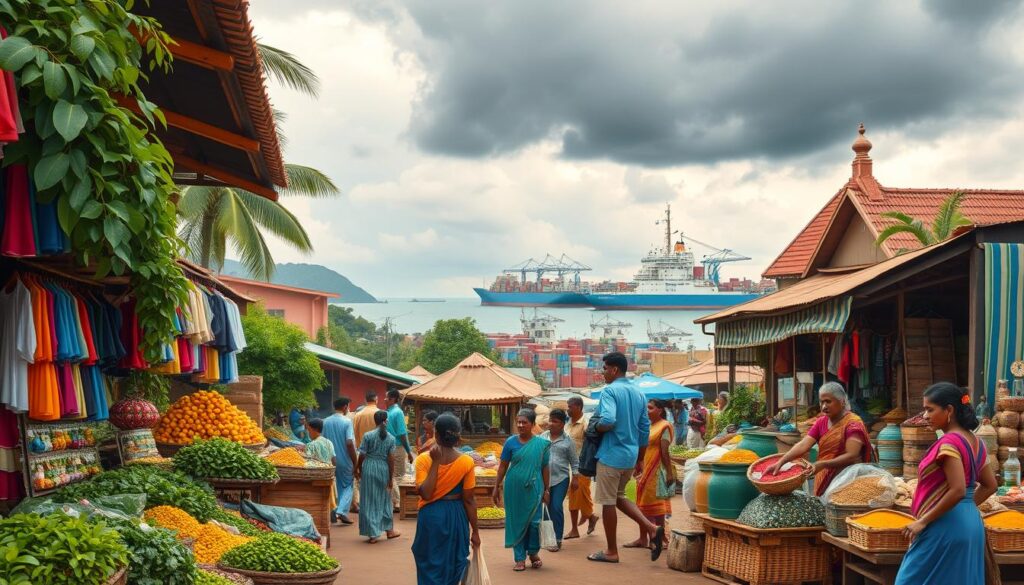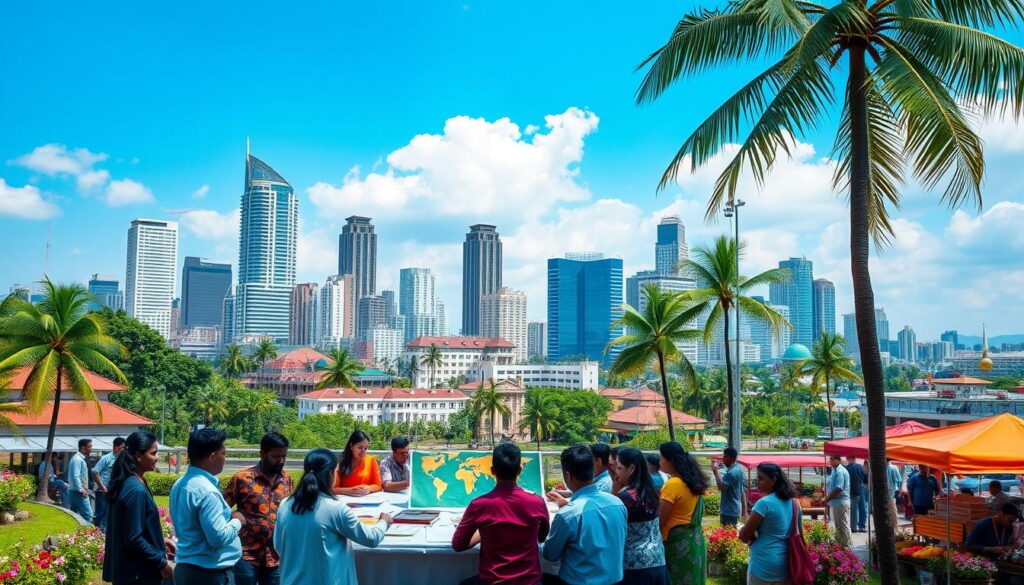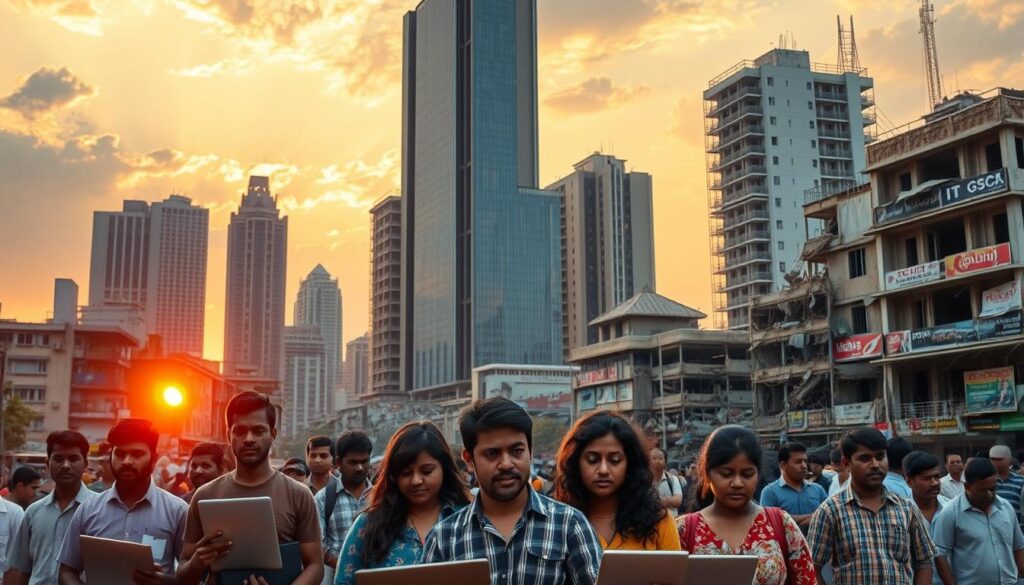Sri Lanka’s Export Performance Declines by 3.49% in Sept 2024
In a shift due to economic recession and global market shrinkage, Sri Lanka’s exports fell in September 2024. Export earnings dropped to US$937.95 million. This was a 3.49% decline from the year before. This dip fits into a larger story of September 2024 economic news. During this time, trade activities hit significant challenges.
Even though merchandise exports fell, Sri Lanka’s service sectors saw growth. They increased by 6.08% to US$329.89 million. This growth shows the economy’s resilience and adaptability. Yet, this did not make up for the overall downturn, where total exports dropped by 1.17% to US$1.27 billion.
However, some areas showed positive trends. The period from January to September 2024 highlights adjustment and opportunity in  . This includes stronger performance in apparel and coconut products. The ICT and logistics sectors also made noteworthy progress. This offers hope for economic recovery.
. This includes stronger performance in apparel and coconut products. The ICT and logistics sectors also made noteworthy progress. This offers hope for economic recovery.
A detailed look by the World Bank’s growth forecast for Sri Lanka delves into the economic scene. It talks about future policies and strategic efforts. These aim to boost and improve Sri Lanka’s export capacity.
An Overview of Sri Lanka’s Export Slump in September 2024
In September 2024, Sri Lanka faced a major decline in exports, showing tough economic challenges. A few areas saw a little improvement. But, mostly, the data showed a significant economic decline in Sri Lanka.
The exports in key merchandise areas went down a lot, showing major September 2024 trade challenges. Yet, the services sector did a bit better, offering hope in tough economic times.
Factors Leading to the 3.49% Decrease in Merchandise Exports
Sri Lanka’s merchandise exports dropped by 3.49%, reaching US$ 937.95 million. This drop was due to less global demand and issues within. Industries like tea, rubber products, and electronics struggled.
Tea exports, which are very important for the country, fell by 10.26%. This decrease added to the economic decline in Sri Lanka.
Contrasting Expansion in Services Exports by 6.08%
On the other hand, service exports grew by 6.08%, totaling about US$ 329.89 million. This increase shows the strength of the information technology and tourism sectors. They used digital tools and global partnerships to face September 2024 trade challenges well.
Total Exports Including Services Fall to $1.27 Billion
Even with the rise in service exports, the total of goods and services exports dropped to $1.27 billion. This was a 1.17% decrease from the year before. It shows the ongoing challenges in trade. It also points out the need for decline in Sri Lanka’s export earnings and the importance of trying new strategies in the economy.
For more information on efforts to improve the economy and stabilize finances, click here. This link will take you to a detailed analysis on how Sri Lanka is dealing with these fiscal challenges.
Sector-Specific Dynamics of Sri Lanka’s Exports in September 2024
The different sectors of Sri Lanka export sectors show a mix of challenges and opportunities. Some parts have stayed strong, despite tough global conditions.
Dip in Key Sectors: Tea, Rubber Products, Electronics, and Seafood
September noticed a big drop in both tea and rubber exports. Tea earnings went down by 2.44% to $117.03 million. This affected the country’s main export goods.
Rubber exports also fell by 4.1%, reaching $79.5 million. These important sectors struggled due to lower global demand and high competition.
Apparel and Textile Sector Resilience Amidst the Decline
However, the apparel and textile sectors did well, growing by 15.71% to $418.68 million. This growth, especially the 36.87% increase in shipments to the United States, shows their strong performance.
The Steady Climb of Coconut-Based Product Exports
The growth in coconut products was also promising. Their exports went up by 10.36%, with big gains in coconut oil and other products. This shows how important diversification is for Sri Lanka export sectors.
This bigger picture shows how Sri Lanka is dealing with economic challenges. For more, see OMB Sri Lanka’s financial strategies in the face of high external debt. It’s about aiming for sustainable growth.
| Product Category | September 2023 Exports (USD Million) | September 2024 Exports (USD Million) | % Change |
|---|---|---|---|
| Tea | 119.88 | 117.03 | -2.44% |
| Rubber Products | 82.81 | 79.5 | -4.1% |
| Apparel and Textiles | 361.79 | 418.68 | +15.71% |
| Coconut Products | Value TBD | Increased | +10.36% |
This table shows the mixed performance in Sri Lanka’s export sectors. It highlights how adaptable sectors like apparel and coconut are helping stabilize and grow the economy.
Highlights from Resilient Sectors Defying the Downward Trend
Despite a 3.49% decline in exports, some areas of Sri Lanka’s economy tell a story of export resilience in Sri Lanka. The ICT sector shines brightly, showing a significant growth in the ICT sector, up by 28.66% in September 2024. It shows the strong foundation tech companies are setting in the economy.
The food and beverage sector also showed strength. It grew by 8.78%, with processed food exports jumping by a huge 69.41%. This growth is crucial, as it brings in foreign money and supports local farms and factories.
The logistics and transport area also stood out, growing by 24.94%. It shows how Sri Lanka’s strategic spot and efficient port management are playing a key role. This highlights the solid potential tying Export resilience in Sri Lanka together.
An in-depth look shows that rising sectors like ICT can help recover what was lost in others. It’s important to focus on these growing areas in Sri Lanka’s future economic plans.
| Sector | Percentage Growth |
|---|---|
| ICT | 28.66% |
| Food and Beverages | 8.78% |
| Processed Food | 69.41% |
| Logistics and Transport | 24.94% |
Even though there’s a downturn in exports, sectors like ICT and food and beverages are doing well. These success stories suggest where policy makers and business leaders should focus. They should aim to boost growth in the ICT sector and improve the performance of food and beverages exports.
Examining the Impact on Sri Lanka’s Trade Dynamics
In September 2024, Sri Lanka’s exports showed interesting trends that tell us a lot about its trade. The United States significantly increased its purchases, with a 21.57% jump, reaching US$ 245.69 million for the month. The growth continued from January to September, rising by 5.33% to US$ 2.19 billion. These numbers highlight strong points in Sri Lanka’s trade, showing resilience in some sectors despite challenges.
The United Kingdom and other major markets also saw growth, improving Sri Lanka’s trade situation. In September, UK exports rose by 3.69%, amounting to US$ 77.75 million. And in the first nine months, there was a 7.06% increase, reaching US$ 691.31 million. This upward trend wasn’t just in the UK but also in other key markets like Germany, the Netherlands, Canada, and China, showing progress.
The Central Bank of Sri Lanka has taken important actions to help the economy. It lowered policy interest rates and reduced required bank reserves. These steps aim to boost economic growth by making more money available for businesses and encouraging spending. Experts believe that along with these actions, Sri Lanka needs to make more changes to strengthen its economy and expand its exports.
Examining the Impact on Sri Lanka’s Trade Dynamics
What were the main factors that led to the 3.49% decrease in merchandise exports?
The decline was mainly due to less global demand. Key sectors like tea, rubber, electronics, and seafood earned less.
How did services exports perform in contrast to merchandise exports?
Despite merchandise exports dropping, services exports grew by 6.08% in September 2024.
What was the total value of exports, including both merchandise and services, for September 2024?
The total exports fell to
Examining the Impact on Sri Lanka’s Trade Dynamics
What were the main factors that led to the 3.49% decrease in merchandise exports?
The decline was mainly due to less global demand. Key sectors like tea, rubber, electronics, and seafood earned less.
How did services exports perform in contrast to merchandise exports?
Despite merchandise exports dropping, services exports grew by 6.08% in September 2024.
What was the total value of exports, including both merchandise and services, for September 2024?
The total exports fell to $1.27 billion. This was a 1.17% drop from the previous year.
Which key sectors experienced a significant slump in export earnings?
Exports in tea, rubber, electronics, and seafood sectors went down notably.
How did the apparel and textile sector fare in September 2024?
The apparel and textile sector grew by 15.71%. This was mainly due to high demand from the U.S.
What was the performance of coconut-based product exports?
Coconut product exports grew by 10.36%. This growth came from coconut oil, desiccated coconut, and liquid coconut milk exports.
Which sectors in Sri Lanka showed significant growth despite the broader economic downturn?
The ICT sector and logistics and transport services saw big growth. The food and beverages sector, especially processed food exports, jumped by 69.41%.
Has the export decline affected Sri Lanka’s trade with major markets?
Despite the overall decline, exports to the United States and the United Kingdom grew. This shows some strong trade connections.
.27 billion. This was a 1.17% drop from the previous year.
Which key sectors experienced a significant slump in export earnings?
Exports in tea, rubber, electronics, and seafood sectors went down notably.
How did the apparel and textile sector fare in September 2024?
The apparel and textile sector grew by 15.71%. This was mainly due to high demand from the U.S.
What was the performance of coconut-based product exports?
Coconut product exports grew by 10.36%. This growth came from coconut oil, desiccated coconut, and liquid coconut milk exports.
Which sectors in Sri Lanka showed significant growth despite the broader economic downturn?
The ICT sector and logistics and transport services saw big growth. The food and beverages sector, especially processed food exports, jumped by 69.41%.
Has the export decline affected Sri Lanka’s trade with major markets?
Despite the overall decline, exports to the United States and the United Kingdom grew. This shows some strong trade connections.




